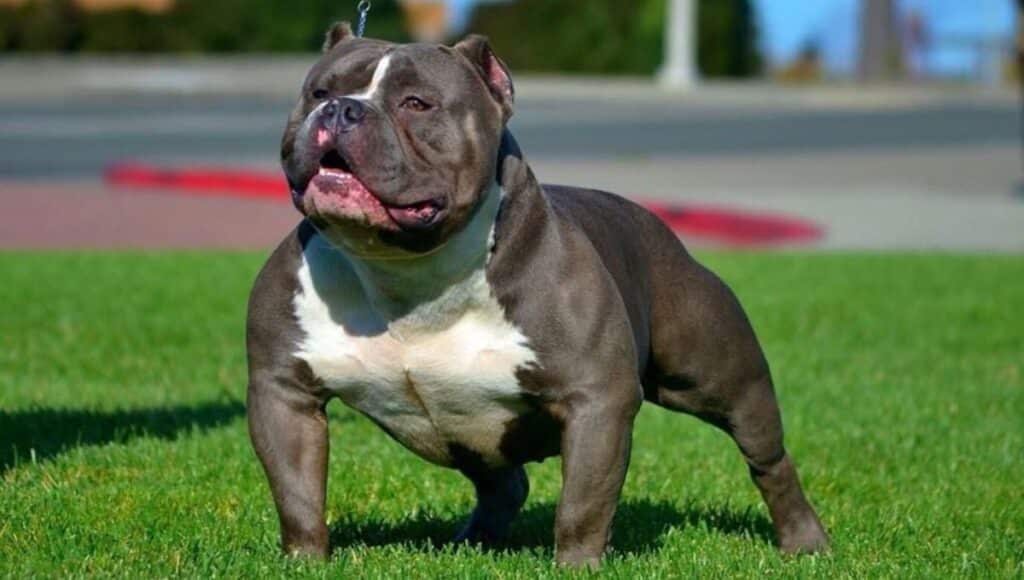In some dog breeds, there is a unique coat pattern called ‘merle,’ caused by a gene that affects coat pigment. This pattern is popular for its distinct appearance, with each merle dog having a unique coat.
However, breeding two merle dogs increases the risk of health problems. Puppies from such matings can be ‘double merles’ or ‘lethal whites,’ often lacking color and prone to severe eye and ear deformities, potentially leading to blindness and deafness.
The intentional breeding of double merles is highly controversial. Organizations like the UK Kennel Club have taken steps to prevent this practice by refusing to register dogs from merle-to-merle matings. This article delves into double merle genetics, affected breeds, health issues, and the debates surrounding their breeding.
The Health Problems Associated With The Merle Gene Mutation
You’ve probably heard of merle coats on dogs, right? That super cool marbled look that makes each pup a one-of-a-kind masterpiece.
But what you might not know is that this unique pattern isn’t just skin deep. The merle gene that creates those jaw-dropping swirls also packs a punch when it comes to potential health issues.
From blindness to deafness and beyond, there’s a lot pet parents need to understand about the risks tied to this genetic quirk. So let’s dive right in and separate the facts from the fiction, shall we?
What Is A Merle?
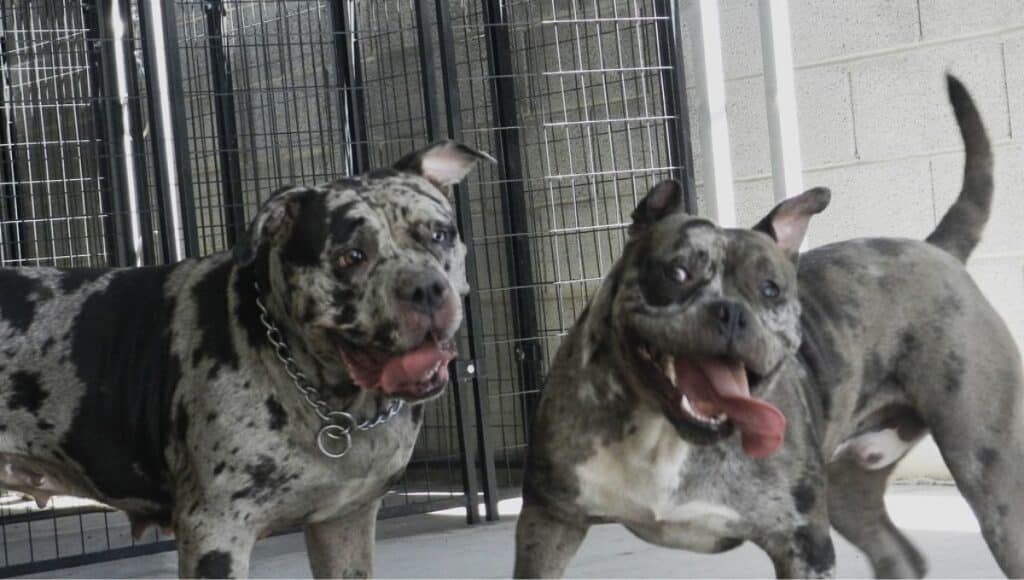
In plain English, a merle dog is one that inherits a specific gene that dilutes or mutes its coat color in random splotchy patterns. The two most common flavors are blue merles (grayish) and red merles (brownish-red).
Some key points:
- Merles often rock stunning blue or multi-colored eyes to match their unique fur
- The marbling effect can be subtle or super vibrant, no two coats are identical
- Occasionally, you’ll spot a “cryptic” merle – a pup that carries the gene but doesn’t visibly show it
So in a litter, you might have:
- Solids (no merle gene at all)
- Obvious merles strutting their stylish coats
- Cryptic merles looking like underdogs until their own litters reveal the truth
The genetics get a bit nerdy, but just know merle is typically a dominant trait. If one parent passes it on, there’s a good chance of merle-marked puppies.
Health Problems Associated With The Merle Gene
Now for the not-so-glamorous part. Multiple studies link the merle gene to some serious health complications:
- Around 1 in 3 merles may face hearing issues from mild to full-blown deafness
- They seem more prone to vision problems and abnormalities too
- Some evidence ties the gene to skeletal, heart, and reproductive defects (though less conclusive)
The root issue? Lack of pigment in vital areas caused by that funky merle gene.
Less pigment in the ears can mess with hearing And pale eyes may struggle with increased eye pressure or vision impairment
Of course, not all merle pups will face these challenges. But owners have to be aware of the heightened risks this unique gene brings to the table.
The Double Merle
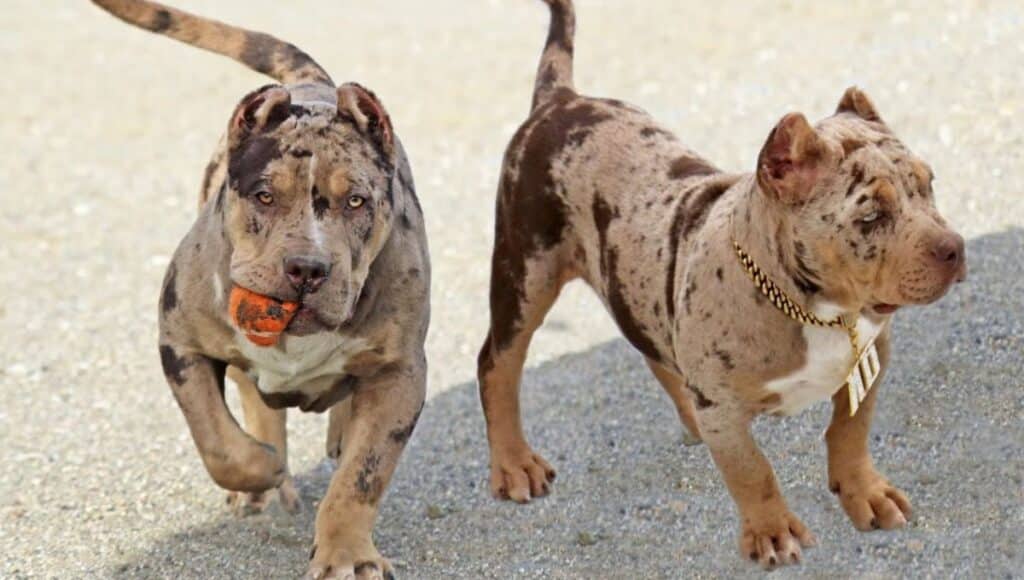
Double dose of trouble. That’s what you get when two merles from any breed have puppies together.
See, each parent passes on one copy of the merle gene (Mm). When combined, you get a 25% chance for double merles (MM) in the litter.
These double-uppers look mostly white with just splotches of color. But their lack of pigmentation is what poses major concerns:
- They face extremely high risks of deafness, blindness or both
- Other abnormalities like skeletal, heart, or reproductive defects are more likely too
On average, a litter will be split into:
- 25% solid-colored non-merles (mm, no gene copies)
- 50% typical merles (Mm, single copy)
- And 25% high-risk double merles (MM, double whammy)
Many breeders euthanize the double-dipped whites at birth to avoid these severe issues. An incredibly tough but perhaps merciful choice for pups facing major disabilities.
Breeds In Which The Merle Coat Is Accepted
While the merle gene is popping up in new breeds constantly, it originated in herding dogs like:
- Australian Shepherds
- Border Collies
- Corgis
- Collies
- Shetland Sheepdogs
It’s also found in several other AKC recognized breeds such as:
- Chihuahuas
- Dachshunds (called “dapple”)
- Great Danes
- Pomeranians
And it’s becoming a rising, controversial trend in:
- Bulldogs
- Pit Bulls
- “Bully” breeds like American Bullies
- Various “designer” mixes
With merle’s popularity booming, you’ll spot it across more and more breed lines nowadays. Both purposefully bred and as accidental litters from two carrier parents.
Blue Merle Controversies
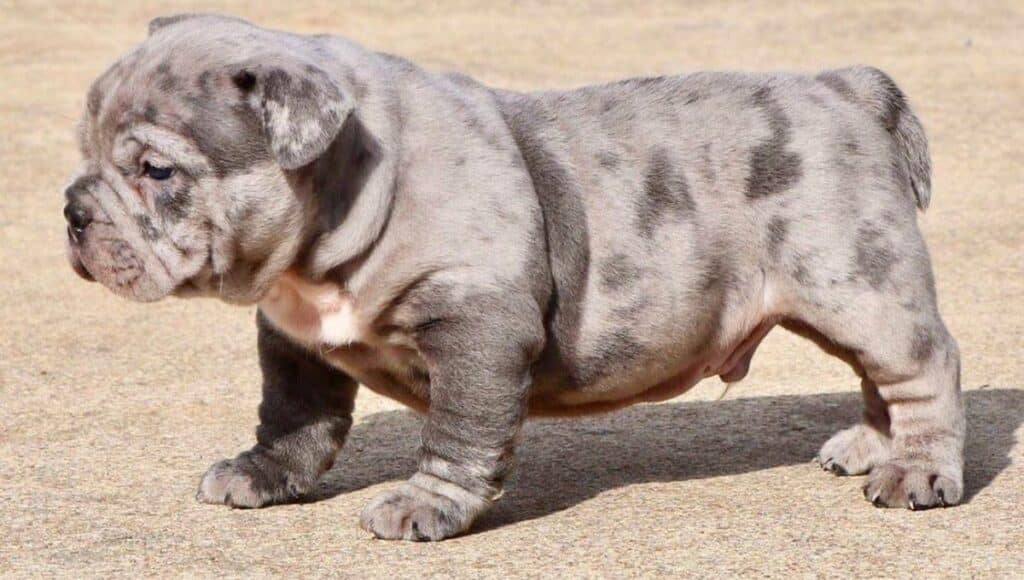
So if breeding two merles risks severe puppy disabilities, why would anyone do it? Well, there’s a few factors at play:
- Pure ignorance – many owners don’t understand the genetic consequences
- Sneaky breeders selling “rare” white double merles to cash in despite the issues
- Or accidents from studding two untested carriers without realizing the risks
The bigger question is – should this breeding practice be allowed at all?
Official kennel clubs and breed organizations are divided. Some have strict policies against double merle litters and won’t register those pups.
Others take a more hands-off approach, leaving the decision to individual breeders and buyers. Giving dogs like double merles a chance at life despite the potential challenges ahead.
Bottom line – it’s a insanely polarizing, heated debate with valid points on both sides. One that all potential merle owners should educate themselves on thoroughly.
Can Double Merles Be Prevented?
While double merles will always occur when two carriers breed, there’s ways to minimize the risks:
- Mandatory genetic testing to identify any cryptic merles before breeding
- Only allowing merle-to-solid breeding, never merle-to-merle
- Better education for new owners on the double merle dangers
- Stricter kennel club policies disqualifying double merle litters
With some smart, ethical breeding practices, these special-colored but high-risk pups could be avoided.
The tricky part? Convincing all breeders (reputable and not) to get on board with the preventative measures. As long as double merles remain marketed as “rare” cash cows, the problem will persist.
M For “Marketing”.. Oops We Mean Merle
Speaking of cash cows, there’s a disturbing new trend giving merle a run for its money:
Unscrupulous breeders are now producing Bulldogs and other “Bully” breeds in every non-standard color imaginable.
From merle to pure white, brown, lilac – you name it and someone’s breeding it as an “exotic” luxury.
These reckless color-chasers are:
- Intentionally breeding for recessive coat genes
- DNA testing to hit those rare shades
- Likely mixing breeds to unlock new exotic palettes
- Then charging insane prices for the outcrosses
All without a care for the pups’ actual health or conforming to breed standards.
It’s all about those dollar signs for these rogue operations. A numbers game fueled by fad marketing rather than ethics or preserving the breed.
Color Breeders
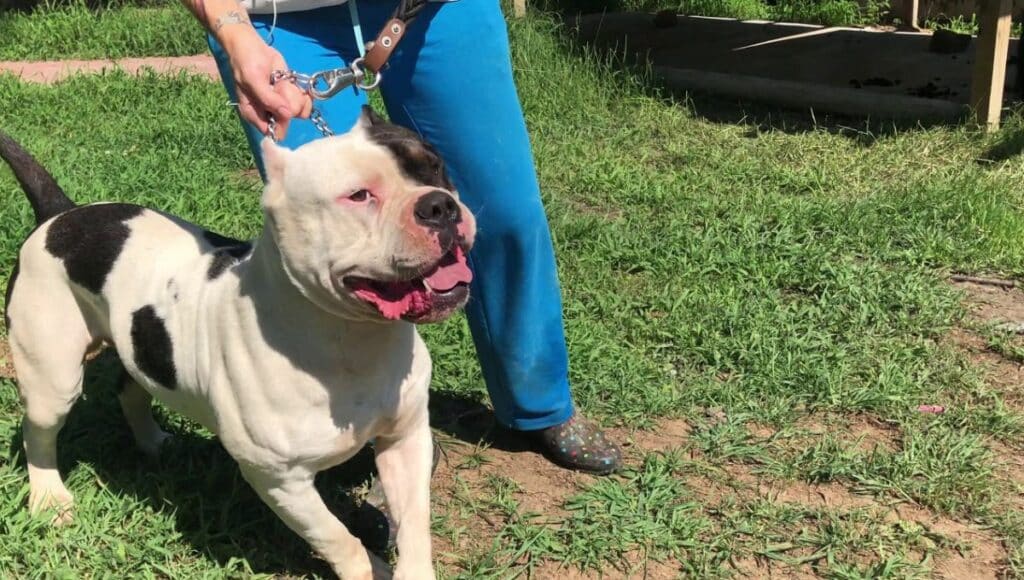
Hear that? It’s the sound of true dog lovers’ hearts breaking across the world.
By erasing all the hard work prior generations put into refining these iconic breeds… By violating the purebred standards established over decades or centuries… All for a quick buck off some trendy, marketable new “colors”.
These opportunistic breeders are sacrificing:
- Desired physical traits by ignoring conformation
- Stable temperaments by carelessly mixing genetics
- Overall health by focusing solely on cosmetics
Any dogs produced this way often wind up:
- Riddled with conformational faults and defects
- Bearing genetic health issues
- Or suffering severe behavioral problems
None of which is fair to the innocent pups simply born into these irresponsible breeding practices.
Worst of all, it gives great breeds a terrible reputation among the uninformed public. Earning bad raps as unhealthy, unstable or unfit companions through no fault of their own.
All because breeders put novelty colors over everything else that matters.
The Bottom Line
Look, there’s nothing inherently wrong with unique colored dogs like merles. Heck, their coats are flat-out stunning to admire!
The issue arises when that distinguishing trait is prioritized over the overall well-being of the dogs.
For merles specifically, breeding two carriers risks producing:
- Vision and hearing disabled “double merle” pups
- Or other def
The Bottom Line (Cont’d)
For merles specifically, breeding two carriers risks producing:
- Vision and hearing disabled “double merle” pups
- Or other defects like skeletal or heart abnormalities
- All for the sake of achieving that unique merle pattern
While stunning, is a marbled coat really worth bringing disabled puppies into the world? Or should that gene be allowed to fade away naturally over generations?
There’s no easy answer, but responsible owners and breeders must weigh the pros and cons carefully. Put the dogs’ quality of life first, not just their marketability.
As for the broader “color craze” plaguing many breeds? That’s an even tougher nut to crack, with greed often overruling ethics.
Until kennel clubs and breed registries take a hard stance…
Until the general public understands what they’re really supporting… Unscrupulous breeders will keep cashing in on these coat color fads and mutations.
No matter how it dulls or distorts the original breed’s brilliant essence and purpose.
No matter the potential health price the pups may pay as a result of the genetic recklessness.
Also Read This Blog
Staying Purebred Vs. Selectively Mixing
Of course, not everyone sees crossbreeding different purebreds as automatically bad either. When executed responsibly with proper health and temperament testing, could it create new hybrid breeds?
“Purists” would argue preserving the original integrity of established breeds should be sacred. While others believe guided crossbreeding allows evolution of exciting new “breeds”.
There’s pros and cons to both schools of thought, fiercely debated among dog folk:
Preserving Purity
- Maintains distinct characteristics over many generations
- Breeds developed for specific jobs can keep excelling
- Fewer unpredictable genetic X-factors in the offspring
Strategic Mixing
- Combines desired traits from diverse breed lines
- Can “refresh” gene pools and increase hybrid vigor
- Allows development of new dog types for roles/owners
No easy answers, but responsible breeders must pick a philosophy and stick to it. Not chase whims and fads that’ll cheapen their breed’s reputation long-term.
Lessons For Merle Owners And Breeders
Clearly there’s a lot to unpack around merle coats, breeding ethics, and deciding a breed’s future direction.
For anyone looking to own, bred, or work with merles, here’s some key takeaways:
- Get educated on the potential health issues surrounding merles, especially double merles
- Never breed two merle dogs together, only to solid Non-carriers
- Thoroughly health test all breeding stock beyond just coat color genes
- Research breeders’ values – are they preserving the breed standard or chasing fads?
- Be willing to say “no” to irresponsible breeding requests that’d harm the breed
At the end of the day, the goal should be producing amazing companions first. Stunning coats are an awesome bonus, but never more essential than stable mentals and robust genetics.
What Does The Future Hold?
Where will this coat color craze lead the dog world next? Hard to say for certain.
Maybe “fad” shades will always chase the next big thing and merles will regain acceptance.
Maybe new breeding tech like gene editing could eliminate risks while enhancing desired traits.
Or maybe the tides will turn back toward embracing and preserving breeds’ original forms too. With “purebred” regaining prestige over extreme aesthetics like super-exotics.
Only time will tell which philosophies the dog community will value going forward.
But you can be sure lively debates will keep raging among breed clubs and kennels:
- The merits of “pure” breeds vs mixed hybrids
- Setting limits on acceptable vs unethical breeding experiments
- Upholding long-revered standards versus trailblazing new breed paths
It’ll take thoughtful, principled breeders avoiding shortcuts for easy money. Prioritizing breeding soundness and stable, healthy pups above all else.
Even if it means parting ways with trendy traits or hues that could threaten a breed’s well-being. The future’s still unwritten – which path will you choose?
Conclusion
The future of dog breeding hinges on responsible, ethical practices that prioritize the well-being of dogs over fads or profits. The merle coat and broader “color craze” present complex debates around preserving breed standards versus allowing new variations.
Thoughtful breeders must carefully weigh the pros and cons, avoid reckless breeding experiments, and put the dogs’ health and stable genetics first—even if it means forgoing trendy aesthetics that could harm a breed.
Only by upholding such principles can the dog community shape a future that respects the breed’s original essence while leaving room for guided evolution toward new roles. The path forward demands principled choices over shortcuts.

